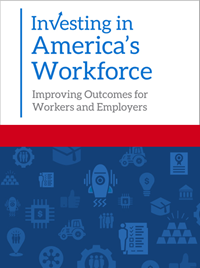The Middle-Skills Gap
In a chapter for Investing in America's Workforce: Improving Outcomes for Workers and Employers, published by the Atlanta Federal Reserve, LISC CEO Maurice A. Jones describes how local solutions are key to filling the middle-skills employment gap and catalyzing opportunity across the country. Using an integrated services approach through the Financial Opportunity Center and Bridges to Career Opportunities models, LISC and its partners have worked with residents of underresourced communities to help them on a pathway to living-wage jobs. These local innovations can enhance traditional workforce development strategies and supply underused talent to meet employers' growing demand for workers.
Excerpt from Chapter 12: The Middle-Skills Gap, Community-Based Solutions to Meet Employer Demands
Official statistics indicate that the economy is strong. The April 2018 national unemployment rate of 3.9 percent was the lowest since 2000 (Bureau of Labor Statistics 2018b; Kitroeff 2018). In many urban neighborhoods and rural communities across the country, however, high unemployment rates persist, and people are struggling to achieve financial stability. Whereas the Atlanta metro area currently has one of the highest job-growth rates in the nation (Bureau of Labor Statistics 2018a) and relatively low unemployment, in nearby Vine City, a neighborhood just west of downtown, the unemployment rate was 19.4 percent, and more than 40 percent of residents lived in poverty as of 2016 (U.S. Census Bureau 2018). The unfortunate reality is that many low- and moderate-income people face persistent barriers to financial security and employment, despite living in cities that are experiencing strong growth.
At the same time, many companies cannot find qualified talent to fill jobs, particularly “middle-skills” positions. These positions generally require more than a high school diploma but less than a four-year bachelor’s degree, as well as additional credentials like technical certifications and associate degrees. Many applicants lack these technical skills in addition to basic reading, writing, and math skills. Yet as recently as 2015, 73 percent of employers reported that they expected their demand for middle-skills positions to increase (Chanmugam, Smith, and Worrell 2014). Estimates suggest that between now and 2024, the U.S. economy will create 16 million middle-skills job openings (National Skills Coalition 2017).
